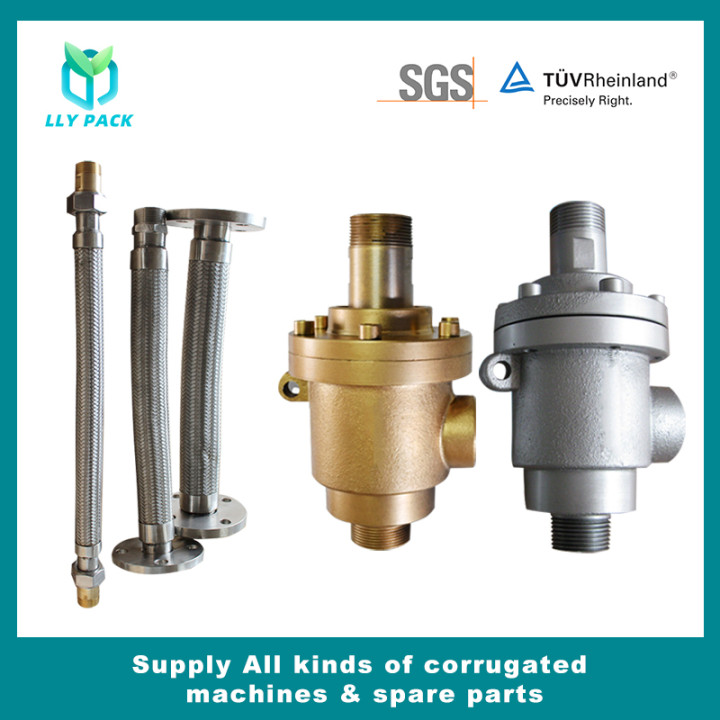There are many factors in the failure of bonding, summed up in the following areas: the ratio of the adhesive preparation; the amount of heat applied; the performance of the paper; mechanical failure and so on. Almost all of these factors are related to the speed of work.
The author categorizes the causes and controls of common failures. It should be pointed out that whether or not the single-sided machine has guide jaws and the heating method of the veneer machine is not the same, it needs to be adjusted according to the actual situation.
Adhesive viscosity: 1. At a certain viscosity, high levels of borax will prevent the release of carrier starch colloids, and excessive borax often leads to large area adhesive failure. 2. Too high an adhesive viscosity tends to prevent the release of moisture from the adhesive while also reducing the degree of wetting of the adhesive against the paperboard. 3. Adhesives are too thin, causing moisture to quickly release from the adhesive, leaving the raw starch severely dehydrated; or have a glassy appearance on the adhesive because the adhesive almost completely enters the terrazzo when in contact with the panel . Control measures: 1. Control water ratio; 2. Borax content must be strictly controlled.
Adhesive application amount: 1. Too little adhesiveness; 2. Too much waste is caused, and the speed of the vehicle is reduced, and the occurrence of wavy streak and warpage is increased. Control measures: Adjust the gelling temperature of the sizing roll: Mainly adjust the amount of NaOH; too low is easy to cure in the sizing system, causing poor glue; excessive white adhesive lines, loose edges, and corrugated machine speed reduce. Control measures: In the season with large temperature difference, the amount of NaOH should be adjusted to adapt to different ambient temperatures; the temperature of the corrugating roller should be strictly approached and the appropriate speed should be adjusted.
Raw paper preheating: In a certain range, the better the heat absorbing adhesive of the paper, the better. 1. When the tissue is fully preheated, the adhesive has dried without sufficient contact with the tissue, or produces a surface bond with the tissue; 2. Insufficient heating of the tissue paper may result in excessive penetration, resulting in insufficient moisture during gelation of the raw starch, and unglued raw starch remains on the bond line, resulting in the appearance of white peony root. Control measures: Monitor the preheater's temperature to ensure that the face paper is warmed up sufficiently. It is advisable to warm up the A, B stencil paper more than the veneer.
Corrugated paper moisture content: 1. The wetted corrugated paper absorbs moisture more easily than starch carrier than dry corrugated paper; 2. Bonding area, causing various forms of warping; 3. The original paper is too high in moisture, tensile strength is reduced, and it easily causes breakage and shutdown. If the machine is stopped for a long time, the cardboard from the hot plate to the cooling zone is heated excessively, resulting in shrinkage of the paper under high temperature, resulting in serious warpage, degumming, and causing the segment. The product is basically a waste product; 4. The base paper is too low in moisture, causing the adhesive to cure before it penetrates, causing false bonding. Control measures: Experience shows that the moisture content should be 9-12%. If the moisture content is too high, the vehicle speed should be slowed down and the temperature of the tile line should be raised. If the moisture content is too low, the pre-regulator should be turned on and the steam should be used to adjust the moisture.
Mechanical adjustment: 1. The fingers have gelatinized starch, and the starch forms a dry stripe by rubbing on the squeegee roll; 2. The finger teeth are too close to the corrugated, preventing the adjustment of the core layer and the sizing roller; 3. There are paper sticks and other adhesives on the sizing roller and the squeegee roller, which will lead to no glue at all. 4. The gap between the sizing roll and the corrugating roll is too large, causing the adhesive not to be coated with a corrugated roof. Control measures: 1. Keep the roller surface clean; 2. Adjust the gap between the rubber roller and corrugating roller; 3. Adjust the gap between guide plate and corrugating roller.
Temperature and pressure roller adjustment: 1. Tile line temperature is insufficient, resulting in insufficient gelatinization; If the pressure on the single-sided pressure roller is too high, the corrugation is easily damaged; if the pressure is too low, the adhesive cannot effectively penetrate and contact. Control measures: tile line temperature should be guaranteed above 170 °C, high-speed tile line should be around 180 °C, the corresponding steam pressure: 10-13kg/cm2.
It should be pointed out that some bond failures may be related to many factors. The operator should try to eliminate various unfavorable factors in order to produce high-quality corrugated cardboard. (Finish)
EnglishEspañolPortuguêsDeutschहिंदी日本語ខ្មែរNederlandsالعربية한국어मराठीMalagasyItalianoPolskiSvenskaελληνικάPусскийภาษาไทยTürkShqipMagyarViệtSamoaМонголMaltiIndonesia FrançaisMelayuҚазақшаYorùbáবাঙালিעִברִיתGàidhligSomaliEesti keelKreyòl Ayisyennorskčeštinaفارسیతెలుగుမြန်မာBosanskiMaoriქართულიRomânăбеларускіУкраїнськаతమిళGaeilgeSuomalainenپښتوລາວհայերենSlovenščinaFilipinoO'zbekÍslenskaייִדישLatviešuGalegoFryskनेपालीKurdîCatalàбългарскиHawaiianHrvatskiਪੰਜਾਬੀWong JawaKiswahililëtzebuergeschisiXhosaEuskalSundaZuluગુજરાતીТоҷикӣ
- Zuhause
- Über uns
-
Produkt-Liste
- Wellblech
- Wellmaschine >
-
Wellmaschinen Ersatzteile >
- Drehgelenk
- Kamm für Slitters Torschütze
- Bremsbelagsatz
- Membranpumpe für Kleber
- Papierstreifen aus Papier
- Expansionsfutter.
- Flexibler Metallschlauch.
- Schleifrad
- Klebeband für Splicer
- Wellwalze
- Schneidklinge
- Überkopfbrückentraktionsgürtel
- Sonnenrad
- Förderband
- NC Schneidklinge
- Kondensatableiter
- Pneumatische Zylinder
- Pneumatische Bremse
- Luftbrübchenfeder
- Vakuumpumpe Wasserring
- Wellmaschinenschmiermittel
- Kautschukhalter
- Titan-plattierter Abstandhalter
- Flexo -Drucker -Slotter
- Flexo -Druckermaschine >
-
Drucker Ersatzteile >
- Kupferplatte
- Druckplatten-Rack
- Aropumpe
- Stahl- und Messingbürste
- Tintenfilter
- Arztblätter
- Ambossabdeckung
- Schaufelblatt
- Faserband
- Hängender Rahmen
- Pet Pre-Strip mit Film
- R- und BAK -Druckkissen
- Fütterungsrad
- Ein Weg mit Lager
- Rotations-Matrize
- Einzelne Membranpumpe.
- Tintenkanalende Block
- Gummiemembran
- Entenbillventil
- Magnetische Kupplungsbremse
- Hanging Groove Strip
- Verpackungsmaschine >
- Kartonmaschine >
- Kartonmaschinenteile >
- Doppelte Fader-Gurte.
- Nähen des Klebensystems >
- Karton Schnittklinge >
- Wolframstahlklinge >
- Schleifrad
- Abfallstripper
- Verpackungsmaschinenklinge >
- Ausrüstung vorab >
-
Industrial Cutting Blade >
- Fliese Schneidkreissägeklinge
- Metallschneideblatt
- Holzschnittsägenklinge
- Nahrungsschneideblatt
- Faserschneidklinge
- Chipper Blade
- Biegeform
- Blatt für Gemüseschneidemaschine
- Stahldünne Klinge
- Tsukatani -Sterbe Klinge
- Drucker Die Schnittklinge
- Maskenmaschinenklinge
- Slitter Rewinder Blade
- TMR Blade
- Tabakkreisklinge
- Scherblade rollen
- Gezacktes Messer für die Verpackungsmaschine
- Papierschneidebandklinge
- Doktorklinge
- Runde Klinge
- Drei Löcher Blade
- Keramikklinge
- Bandmesserklinge für Stoff
- Bandmesserklinge für Schwammschaum
- Bandmesserklinge für die Spaltmaschine
- Bandmesserklinge für Papier
- Messerhalter
- Industrial Cutting Blade
- Fräser
- Winkelmühle
- Shredder Blade
- V Grooving Blade
- Elektrische Schere
- CNC Machine Blade & Tools
- Lebensmittelverarbeitungsklinge
- Nachricht
- Video
- Kontakten
- Anfrage versenden










